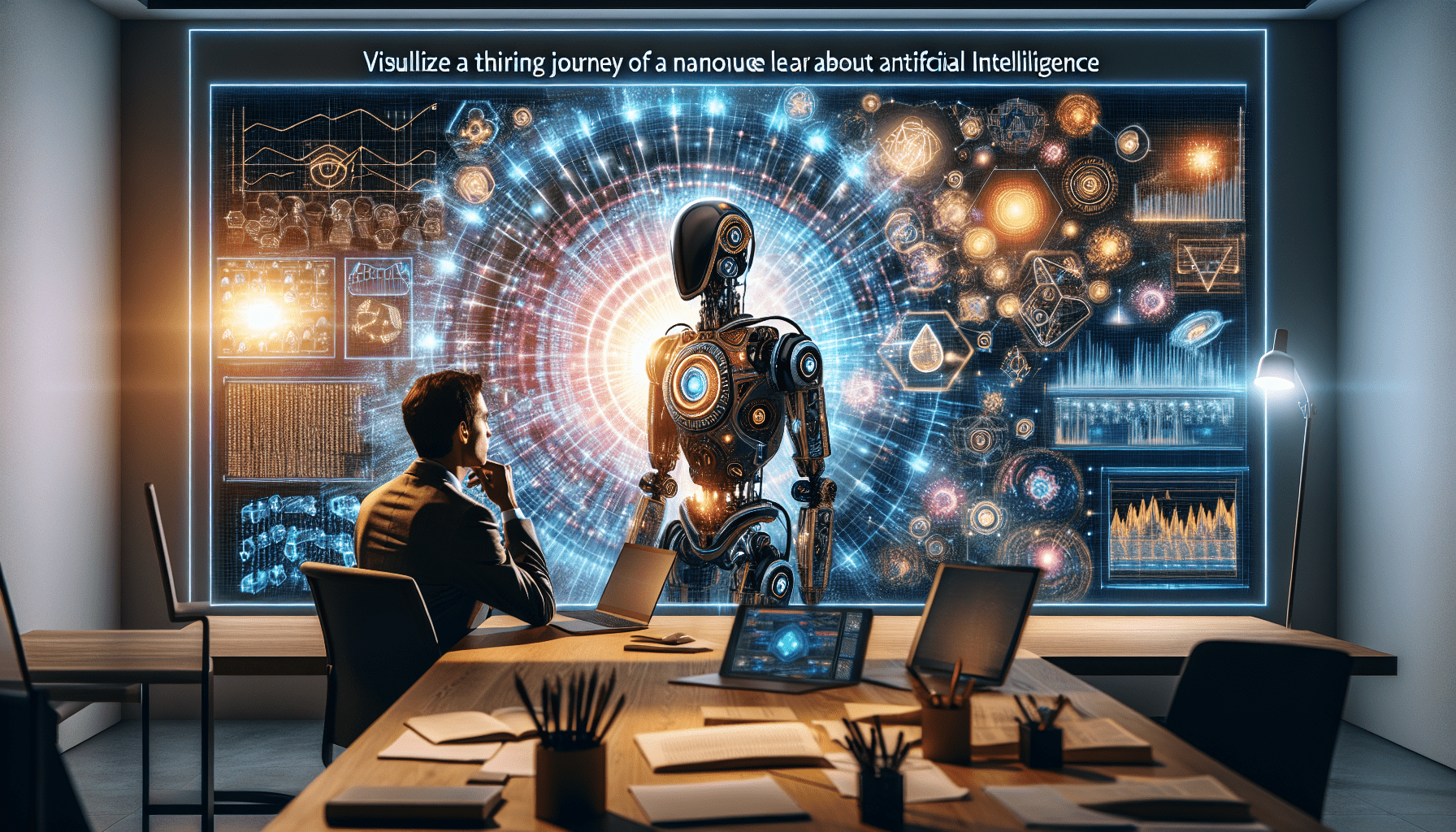Embark on a thrilling expedition as you enter into the captivating realm of Artificial Intelligence. In this enlightening journey, you will discover the fascinating possibilities that AI holds and unravel the mysteries behind this remarkable technology. Prepare to be amazed as you navigate through the intricacies of AI, unraveling its intricate layers and delving into the extraordinary advancements that have revolutionized our world. Whether you are a novice or a tech-savvy individual, this article will guide you through the incredible landscapes of AI, providing you with valuable insights and nurturing your curiosity along the way. Get ready to witness the power and potential of Artificial Intelligence and embark on a voyage that will surely leave you in awe. Let’s dive in!
Understanding Artificial Intelligence
Artificial Intelligence (AI) is a fascinating field that has gained immense popularity in recent years. It involves the development of intelligent machines that can perform tasks that typically require human intelligence. In this article, we will delve into the world of AI and explore its different aspects.
Defining Artificial Intelligence
Artificial Intelligence can be defined as a branch of computer science that focuses on creating intelligent machines capable of simulating human behavior. These machines are designed to think, learn, and problem-solve like humans, using algorithms that analyze vast amounts of data. AI encompasses various subfields, including machine learning, natural language processing, robotics, and more.
Types of Artificial Intelligence
There are different types of AI, each with its own characteristics and capabilities. The two main types of AI are Narrow AI and General AI. Narrow AI, also known as Weak AI, is designed to perform specific tasks, such as voice recognition or image classification. On the other hand, General AI, also known as Strong AI, refers to machines that possess the ability to understand, learn, and apply knowledge across different domains.
The History of Artificial Intelligence
The concept of Artificial Intelligence dates back to ancient times, but the field as we know it today began to take shape in the 1950s. Here, we will explore the beginnings of AI, significant milestones in its development, and its current state.
The Beginnings of AI
The roots of AI can be traced back to the early work of pioneers like Alan Turing and John McCarthy. Alan Turing proposed the idea of a “universal machine” that could mimic any other machine’s behavior. John McCarthy coined the term “artificial intelligence” and organized the Dartmouth Conference, which marked the birth of AI as a field of study.

Milestones in AI Development
Over the years, AI has witnessed significant milestones that have shaped its growth. In 1956, the first AI conference in Dartmouth led to increased interest in the field. In the 1990s, machine learning algorithms made significant advancements, leading to the development of intelligent systems. More recently, breakthroughs in deep learning and neural networks have accelerated the progress of AI.
Current State of AI
Artificial Intelligence has made tremendous strides in recent years. Today, AI is integrated into various aspects of our lives, from voice assistants on our smartphones to self-driving cars. AI technologies are applied in industries such as healthcare, finance, and marketing, revolutionizing the way we live and work. However, there are still challenges to overcome, particularly in the areas of ethics and privacy.
Applications of Artificial Intelligence
Artificial Intelligence has become an integral part of our everyday lives. Its applications are wide-ranging, from improving everyday tasks to transforming entire industries. Here, we will explore the different areas where AI is making a significant impact.
AI in Everyday Life
AI has become a part of our daily routines, often without us even realizing it. Voice assistants like Siri and Alexa use natural language processing algorithms to understand and respond to our commands. AI-powered recommendation systems suggest personalized content on streaming platforms and online shopping websites. Smart home devices, such as thermostats and security systems, use AI to adapt to our habits and preferences.

AI in Business
Artificial Intelligence is transforming the business landscape, enabling organizations to streamline operations, enhance productivity, and make data-driven decisions. Businesses leverage AI-powered chatbots for customer support, reducing response times and improving customer satisfaction. AI-powered analytics tools help companies gain insights from vast amounts of data, leading to more informed decision-making. Machine learning algorithms are leveraged to optimize marketing campaigns, improve supply chain management, and detect fraud.
AI in Healthcare
In the field of healthcare, AI holds immense potential to revolutionize patient care, diagnosis, and treatment. AI algorithms can analyze medical images and detect anomalies, helping physicians make accurate diagnoses. Natural language processing enables intelligent chatbots to interact with patients, providing round-the-clock healthcare support. AI-powered tools can predict disease outbreaks, monitor the spread of infectious diseases, and assist in drug discovery.
AI in Social Media
Social media platforms have harnessed the power of AI to enhance user experiences and deliver relevant content. AI algorithms analyze user data to personalize content feeds, ensuring users see posts and ads that align with their interests. Image recognition algorithms help detect and filter objectionable or inappropriate content. AI-powered sentiment analysis can gauge public opinion, helping businesses better understand their target audience.
Machine Learning and Deep Learning
Machine Learning (ML) and Deep Learning (DL) are subsets of Artificial Intelligence that play a crucial role in enabling intelligent systems. Here, we will explore the concepts and significance of ML and DL.

Introduction to Machine Learning
Machine Learning is a subset of AI that focuses on developing algorithms that allow computers to learn and make predictions from data without being explicitly programmed. ML algorithms are designed to analyze patterns, recognize trends, and make decisions based on past experiences. Supervised learning, unsupervised learning, and reinforcement learning are the three primary paradigms of machine learning.
Basic Concepts in Machine Learning
In machine learning, data plays a crucial role. Training data is used to build models that can make predictions or decisions. Features are the measurable characteristics of the data that the model uses for learning. The model’s performance is evaluated using metrics such as accuracy, precision, and recall. Model training involves selecting an appropriate algorithm, optimizing hyperparameters, and iterative refinement.
The Significance of Deep Learning
Deep Learning is a subfield of ML that focuses on developing algorithms inspired by the human brain’s neural networks. Deep Learning models, known as artificial neural networks, consist of layers of interconnected neurons. These models can learn complex patterns and hierarchies in data, making them particularly effective in tasks such as image recognition, natural language processing, and speech synthesis. Deep Learning has achieved notable successes in various fields, including computer vision and autonomous vehicles.
Understanding Neural Networks
Neural Networks are at the core of many AI applications, including deep learning. Here, we will explore what neural networks are, the different types, and how they work.

What are Neural Networks?
Neural Networks, also known as artificial neural networks (ANNs), are computational models that simulate the behavior of the human brain’s biological neurons. These networks consist of interconnected nodes, or artificial neurons, which process and transmit information. By learning from data, neural networks can perform tasks such as pattern recognition, classification, and regression.
Types of Neural Networks
There are several types of neural networks, each designed for different purposes. Feedforward neural networks are the most basic type, where information flows in only one direction. Convolutional Neural Networks (CNNs) are specialized for image processing tasks, while Recurrent Neural Networks (RNNs) are effective for sequential data such as text and speech. Long Short-Term Memory (LSTM) networks are a type of RNN that can remember long-term dependencies in data.
How Neural Networks Work
Neural networks process information through a series of interconnected layers. The input layer receives data, which is then passed through hidden layers that perform computations. Finally, the output layer produces the network’s response or prediction. During training, the network adjusts its parameters, known as weights, based on the errors it makes. This iterative process enables the network to improve its performance over time.
Natural Language Processing
Natural Language Processing (NLP) is a subfield of AI that focuses on the interaction between computers and human language. Here, we will explore what NLP is, its applications in speech recognition, and language translation.

What is Natural Language Processing?
Natural Language Processing involves the development of algorithms and models that enable computers to understand, interpret, and generate human language. NLP techniques are applied in various tasks, including speech recognition, sentiment analysis, machine translation, and text generation. By processing and analyzing vast amounts of textual data, NLP algorithms can extract meaningful insights and enable intelligent interactions.
NLP in Speech Recognition
Speech recognition technology utilizes NLP algorithms to convert spoken language into written text. This technology enables voice assistants and dictation software to understand and process spoken commands or conversations. Speech recognition has transformed the way we interact with our devices, allowing us to control them with voice commands and improving accessibility for individuals with disabilities.
NLP in Language Translation
Language translation has also been revolutionized by NLP algorithms. Machine translation systems leverage NLP techniques to automatically translate text from one language to another. These systems can translate large volumes of text with reasonable accuracy, facilitating communication and breaking down language barriers. However, challenges remain in accurately capturing contextual nuances and preserving the original meaning of the text.
Robotics and Artificial Intelligence
The integration of AI and robotics has opened up exciting possibilities in fields such as manufacturing, healthcare, and exploration. Here, we will explore how AI is driving advancements in robotics and the capabilities of AI robots.
Integration of AI and Robotics
The combination of AI and robotics has resulted in intelligent machines that can perform tasks with accuracy, speed, and adaptability. AI algorithms provide robots with the ability to perceive and interact with their environment, make decisions based on sensory information, and learn from past experiences. Through machine learning, robots can optimize their performance, adapt to changing conditions, and improve their capabilities.
AI Robots in Manufacturing
AI robots have revolutionized the manufacturing industry by automating repetitive and dangerous tasks. These robots can perform tasks such as assembly, welding, and quality control with precision and efficiency. AI-powered robots work alongside human operators, enhancing productivity and reducing the risk of workplace accidents. The integration of vision systems and sensors enables robots to navigate complex environments and interact safely with humans.
Reasoning and Planning in AI Robots
AI robots possess the ability to reason and plan, enabling them to solve complex problems and perform tasks that require higher-level thinking. Robots equipped with AI algorithms can analyze data, assess different options, and make decisions based on predefined goals and constraints. This capability is particularly valuable in fields such as search and rescue, space exploration, and autonomous vehicles.
Ethical Considerations in Artificial Intelligence
As AI becomes more prevalent in various aspects of our lives, ethical considerations come to the forefront. Here, we will explore some of the ethical challenges and implications of AI.
AI and Privacy
AI applications often require access to vast amounts of personal data to provide personalized experiences. This raises concerns about privacy and data security. Safeguarding sensitive information and ensuring the responsible use of data is crucial in AI development. Striking a balance between the benefits of AI and individual privacy rights is an ongoing challenge that requires careful regulation and robust data protection measures.
Bias and Fairness in AI
AI systems are only as good as the data they are trained on. If the training data is biased or unrepresentative, it can lead to biased outcomes and discriminatory practices. Bias in AI systems can perpetuate societal inequalities, reinforce stereotypes, and lead to unfair decision-making. Ensuring fairness and mitigating bias in AI algorithms is essential to promote equality and prevent discriminatory practices.
AI and Job Displacement
The rise of AI and automation has raised concerns about job displacement and the impact on the workforce. While AI may eliminate certain types of jobs, it also creates new opportunities and shifts the nature of work. It is important to focus on reskilling and upskilling the workforce to adapt to the changing demands of the job market. Additionally, exploring the ethical implications of AI in the context of job displacement is crucial to ensure a just and inclusive society.
The Future of Artificial Intelligence
The field of Artificial Intelligence is constantly evolving, with exciting advancements on the horizon. Here, we will explore some of the future prospects and emerging technologies in AI.
Advancements in AI Research
Researchers are continuously pushing the boundaries of AI, aiming to develop more advanced systems capable of complex cognition and reasoning. Advancements in areas such as explainable AI, quantum computing, and neuromorphic engineering hold promise for the future of AI. Researchers are also exploring interdisciplinary approaches, combining AI with fields like biology, psychology, and physics, to develop more holistic and intelligent systems.
Emerging Technologies in AI
Several emerging technologies have the potential to shape the future of AI. Reinforcement Learning, a branch of machine learning, is enabling AI systems to learn through trial and error, similar to how humans acquire new skills. Generative Adversarial Networks (GANs) are facilitating the generation of realistic data and images. Quantum AI, leveraging quantum computing, could revolutionize machine learning algorithms by solving complex problems much faster.
Getting Started with Artificial Intelligence
If you are interested in diving into the world of Artificial Intelligence, there are several ways to get started. Here, we will explore online courses and tutorials, open-source AI tools and libraries, and the importance of joining AI communities.
Online Courses and Tutorials
Numerous online platforms offer AI courses and tutorials, catering to individuals with varied levels of expertise. These courses cover topics such as machine learning, deep learning, natural language processing, and robotics. Online tutorials provide step-by-step guidance on implementing AI algorithms and models, allowing you to gain hands-on experience.
Open-source AI Tools and Libraries
Open-source AI tools and libraries are readily available for developers and researchers. These tools provide a framework for implementing AI algorithms, making it easier to experiment and build intelligent systems. Popular AI libraries such as TensorFlow and PyTorch offer extensive documentation and a supportive community, enabling developers to leverage pre-existing models and code to jumpstart their AI projects.
Joining AI Communities
One of the best ways to learn and stay updated in the field of AI is to engage with AI communities. Online forums, discussion boards, and social media groups provide platforms to connect with fellow AI enthusiasts, share knowledge, and collaborate on projects. Attending AI conferences and meetups allows you to network with professionals, attend informative sessions, and gain insights into the latest advancements in AI.
Artificial Intelligence is a dynamic and rapidly evolving field that has the potential to shape the future. By understanding the different aspects of AI, its applications, and the ethical considerations involved, you can embark on a journey of exploration and innovation in this exciting field.






Leave a Reply